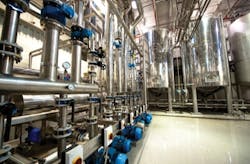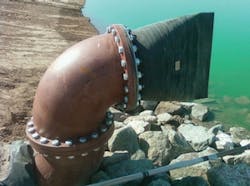Why Green Infrastructure and I/I Control Go Hand in Hand
By Karen Sands and Tom Chapman
There is no simple solution to eliminating sanitary sewer overflows and related basement backups in urban environments. Although collection systems may be well under capacity during dry weather, when it rains or when snow melts, groundwater and infiltrating stormwater (often called clearwater) can migrate into leaky sanitary collection systems. This happens on private property, particularly into laterals that need maintenance, as well as in community sewer pipes. Because of the impervious nature of urban areas, stormwater runoff can increase significantly during large storms.
How does all this clearwater get into pipes that aren't designed to convey it? Foundation drains, roof downspouts and illegal sump pump discharges are typical sources of inflow to the sanitary system. Couple these inflow sources with leaky pipes that infiltrate, and parts of the sewer system can become overwhelmed and in need of relief - either purposely into area waterways as an overflow or surcharged as backups into local basements.
The Milwaukee Metropolitan Sewerage District (MMSD) strives to avoid both overflows and backups and, as such, is undertaking a significant program with area communities to lessen this need for sewer system relief. MMSD is recommending that $150 million be spent over the next 10 years to find and reduce sources of inflow and infiltration (I/I) that inundate the sewer system.
In the Greater Milwaukee Watersheds served by MMSD, there are over 3,000 miles of privately owned, aging sewer laterals that typically receive little or no maintenance. Clearwater pouring and/or leaking into the interconnected system on the private side affects both community systems and MMSD systems in significant ways, particularly during large rain events. One recent study in Wauwatosa (an inner-ring suburb of Milwaukee) found I/I rates of up to 55 gallons per minute. As a result, MMSD identified poorly performing sewersheds in 23 neighborhoods and is requiring that communities reduce I/I rates based on a performance schedule.
Media attention recently focused on the issue of I/I in Milwaukee and peaked in July 2010 when significant storms - one in particular - dumped over eight inches of rain over a 24-hour period on the northern half of the metropolitan area, causing stormwater drainage issues and basement backup damage. Public reaction was to blame government, although no system is designed to manage that much rain. Even so, government is responding. MMSD will expand a program to help municipalities inspect laterals, provide engineering services, and educate the public about the fixes needed. But that alone will not solve the issue of surcharging.
Green infrastructure - strategies that infiltrate, evapotranspire, capture and reuse stormwater - is another important component, along with inflow source reduction and infrastructure repair. MMSD has studied this through computer modeling and numerous small-scale demonstration projects.
A recent MMSD document titled "Fresh Coast Green Solutions" identified 10 green infrastructure strategies that can store and manage stormwater while also providing a host of other benefits. Green infrastructure helps the community and MMSD sewer systems by reducing runoff volumes leaving a site, which in turn reduces unintended stormwater infiltration. In fact, a draft MMSD report, "Determining the Potential of Green Infrastructure to Reduce Overflows in Milwaukee," which used the model SUSTAIN, found that "green infrastructure has the potential to yield very significant benefits to both hydrology and water quality in the SSSA [separate sanitary service area]". MMSD knows from this work that green infrastructure can be an important complement to the extensive network of grey infrastructure in the region.
In the past, concern about stormwater infiltrating from green infrastructure into leaky sanitary pipes has been a topic of discussion at MMSD but there was a general lack of data on the subject. To study this, MMSD commissioned four projects in 2005 and 2006 to determine the potential for green infrastructure to infiltrate into the sanitary system. Consultants conducted two of the projects, one was conducted by the City of Milwaukee, and the fourth was conducted by the University of Wisconsin-Milwaukee.
The green infrastructure measures tested in the MMSD studies included porous pavement, rain gardens, and stormwater ponds. Findings included:
- In the case of large-scale stormwater ponds, no evidence of inflow and infiltration into sewer pipes was detected from stormwater storage ponds 60 feet or greater from pipes (shorter distances were not tested).
- For smaller-scale green infrastructure, a horizontal distance of at least 10 feet from pipes is recommended, and even shorter distances will probably not lead to significant increases in infiltration to pipes.
Besides leaky pipes and the distance between them and green infrastructure, soil types play a role in determining how green infrastructure can complement I/I reduction. That's because soil types influence infiltration rates and capacity. Water infiltrates quickly and vertically in sandy soils, while in clay soils, such as are present in Milwaukee, water infiltrates relatively slowly and with a wider vertical component. Additional research is needed to better characterize the connection between soil types and infiltration into leaky pipes.
Beyond the immediate leakage into the pipes, there are two additional regional factors to consider. These include:
- Green infrastructure's ability to reduce out-of-bank flooding. Green infrastructure can reduce the volume of stormwater runoff and where that reduction might be significant, there's an inherent ability to reduce out-of-bank flooding. In Milwaukee, collector sewers often follow watercourses. MMSD's 2020 Facilities Plan reports that green infrastructure can reduce the 100-year storm peak by 22 percent under given conditions (and by a greater percent in smaller storms). Therefore, reducing out-of-bank flooding may reduce the potential for inflow into sanitary sewers.
- Green infrastructure's infiltration process and the potential to increase groundwater levels that might actually increase infiltration into leaky sanitary sewers. Further modeling/monitoring is required to predict the impact of this factor.
In addition, the investment in sewers being made by MMSD and the communities to reduce I/I indicates the important need to address infrastructure in need of repair. We shouldn't blame the pipes that convey water away or the green infrastructure designed to infiltrate. Rather, finding and fixing problems and then identifying ways in which the two practices can be complementary is needed.
Photo: City of Wauwatosa.
Several green measures - when properly located - will actually help reduce inflow and infiltration into pipes. Two examples:
Providing a rain garden at the end of a sump pump discharge: Many older homes in the Milwaukee region have foundation drains directly connected to the sanitary sewer system. One approach to removing I/I from the sanitary system is to disconnect the foundation drains and install a sump pump that discharges to the lawn. A rain garden may complement the lawn discharge, helping water to infiltrate into the ground. This will help manage Clearwater, provided the rain garden is not directly over a sewer lateral that may leak.
Providing a rain barrel or cistern to catch roof runoff from a downspout: Many homes in the Milwaukee region have roof downspouts connected to combined sewers (or, illegally, to separate sewers) or to the storm sewer. One approach to removing inflow is to disconnect the downspout and direct runoff into a rain barrel (with overflow to a rain garden). In addition, slowing the path of stormwater by catching it in a container will slow its delivery to storm sewers and, in doing so, reduce its potential to infiltrate into sanitary sewers.
With an integrated program, MMSD can define the selection, design and location of green infrastructure strategies to provide the maximum benefit while minimizing I/I. Because of this, MMSD is continuing down a dual path that includes repairing and addressing sources of I/I while also supplementing the system with widespread, strategically placed green infrastructure. This will help the MMSD system function at its best, help keep basements dry when it rains, and provide an additional safety factor in the face of a changing climate that has brought bigger storms in recent years.
WW
About the Authors: Karen Sands, AICP, is Manager of Sustainability and Tom Chapman, PE, is an engineering manager for Milwaukee Metropolitan Sewerage District.
About MMSD:
The Milwaukee Metropolitan Sewerage District is a state-chartered, governmental agency providing wastewater services for about 1 million people in 28 municipalities. The District's chief responsibilities are to provide sewage treatment services and to maintain and improve watercourses for nearly all of Milwaukee County, Wisconsin, and portions of municipalities in surrounding counties.
MMSD owns about 300 miles of sewers and two water reclamation facilities (WRFs). It receives wastewater through a 3,000-mile system of collector sewers owned by 28 communities and a similar amount of private laterals. Within the MMSD system, there are six miles of combined sewers (95% of sewers in the region are separate), 23 miles of near surface collectors, and 23 miles of inline storage. On average, the two WRFs collect and treat more than 200 million gallons of wastewater each day. With a daily capacity of 600 million gallons, they return clean, clear water to Lake Michigan.
About SUSTAIN:
SUSTAIN is a new decision-support system from US EPA's Office of Research and Development intended to help users select and place green infrastructure measures in urban watersheds to manage the quantity and quality of stormwater runoff. It's useful for tasks such as developing total maximum daily loads (TMDLs), optimizing green infrastructure strategies to reduce combined sewer overflow volumes, achieving reductions to meet municipal separate storm sewer system (MS4) permit requirements, and meeting other water quality and cost-effectiveness goals.
More WaterWorld Current Issue Articles
More WaterWorld Archives Issue Articles


